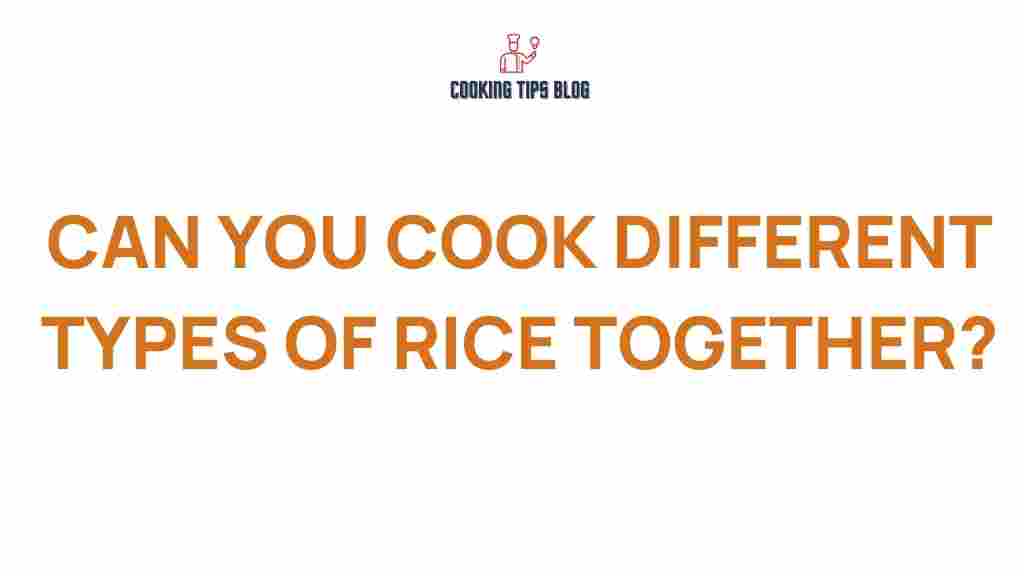The Art of Cooking: Can You Really Cook Different Types of Rice Together?
When it comes to rice cooking, there are countless varieties and methods to explore. From fluffy jasmine to hearty brown rice, each type has its unique characteristics and cooking requirements. But can you really combine different types of rice in a single dish? This article will delve deep into the art of cooking rice, exploring how to successfully cook different types together while also highlighting some practical tips, tricks, and troubleshooting methods.
Understanding Different Types of Rice
Before diving into the intricacies of rice cooking, it’s essential to understand the various types of rice available. Each type has its distinct flavor, texture, and cooking time:
- White Rice: This is the most common type, often used in a variety of dishes. It cooks quickly and has a soft texture.
- Brown Rice: Whole grain rice that retains its bran layer. It takes longer to cook and has a nuttier flavor.
- Jasmine Rice: A fragrant, long-grain rice popular in Thai cuisine. It has a slightly sticky texture when cooked.
- Basmati Rice: Known for its long grains and aromatic flavor, this rice is commonly used in Indian dishes.
- Wild Rice: Technically a grass, wild rice has a chewy texture and earthy flavor, often used in salads and stuffing.
Can You Cook Different Types of Rice Together?
The short answer is yes, but with some caveats. Combining different types of rice can lead to unique flavors and textures in your dishes. However, since different rice varieties have varying cooking times and water absorption rates, it requires careful planning.
Step-by-Step Process for Cooking Mixed Rice
Here’s a step-by-step guide to successfully cooking different types of rice together:
Step 1: Choose Compatible Rice Varieties
Before you start, select rice types that have similar cooking times. For example, combining jasmine rice with white rice is feasible, while mixing brown rice with white rice may not yield the best results due to the longer cooking time of brown rice.
Step 2: Rinse the Rice
Rinsing rice removes excess starch and helps avoid clumping. Place the rice in a fine-mesh strainer and rinse under cold water until the water runs clear.
Step 3: Adjust the Water Ratio
Different types of rice absorb water differently. A general ratio for cooking rice is 1 cup of rice to 2 cups of water. However, when mixing rice, it’s crucial to adjust the water according to the type that requires the most. For instance:
- White Rice: 1 cup rice to 2 cups water
- Brown Rice: 1 cup rice to 2.5 cups water
- Jasmine Rice: 1 cup rice to 1.75 cups water
In a mix, use the ratio of the rice requiring more water. It’s often best to stick with a ratio that accommodates the longest cooking time.
Step 4: Cook the Rice
Combine the rinsed rice and the appropriate amount of water in a pot. Bring it to a boil, then reduce the heat to a simmer, cover, and cook for the time required for the type of rice that takes the longest. For example:
- Brown rice typically takes about 40-45 minutes.
- White rice usually takes about 18-20 minutes.
Check the rice periodically to ensure it doesn’t overcook or dry out.
Step 5: Fluff and Serve
Once cooked, remove the pot from heat and let it sit covered for 10 minutes. This resting time allows the rice to steam and become fluffy. Finally, fluff the rice with a fork before serving.
Troubleshooting Tips for Cooking Mixed Rice
Even with careful planning, you may encounter issues when cooking mixed rice. Here are some common problems and solutions:
- Rice is Undercooked: If some rice is still hard, add a little more water, cover, and cook for an additional 5-10 minutes.
- Rice is Overcooked: If the rice is mushy, try spreading it out on a baking sheet to cool and let some moisture evaporate.
- Uneven Cooking: To avoid this, make sure to use rice varieties with similar cooking times or adjust water accordingly.
For more detailed cooking techniques and recipes, check this resource.
Conclusion
Cooking different types of rice together is an art that can yield delicious and unique results when done correctly. By understanding the characteristics of each rice type, choosing compatible varieties, and following the proper cooking methods, you can elevate your dining experience. Remember, successful rice cooking takes practice and experimentation, so don’t be afraid to try new combinations and flavors.
Happy cooking, and enjoy the wonderful world of rice!
This article is in the category Recipes and created by Cookingtipsblog Team
